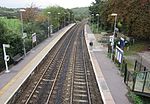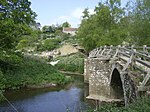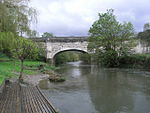Church of St Peter, Freshford
15th-century church buildings in EnglandChurch of England church buildings in Bath and North East SomersetGrade II* listed buildings in Bath and North East SomersetGrade II* listed churches in Somerset

The Anglican Church of St Peter in Freshford within the English county of Somerset dates from the 15th century. It is a Grade II* listed building.Parts of St Peter's Church, which is on the north side of the village, date back to the fifteenth century. The three stage tower, which is supported by diagonal buttresses, was added in 1514. The church underwent Victorian restoration by Charles Edward Davis.The churchyard has a number of Georgian chest tombs, dating from the late 18th and early 19th century, four of which are listed in their own right.The parish is part of the benefice of Freshford with Limpley Stoke and Hinton Charterhouse within the Diocese of Bath and Wells.
Excerpt from the Wikipedia article Church of St Peter, Freshford (License: CC BY-SA 3.0, Authors, Images).Church of St Peter, Freshford
Church Hill,
Geographical coordinates (GPS) Address External links Nearby Places Show on map
Geographical coordinates (GPS)
| Latitude | Longitude |
|---|---|
| N 51.34 ° | E -2.3033333333333 ° |
Address
Saint Peter's
Church Hill
BA2 7TX
England, United Kingdom
Open on Google Maps









